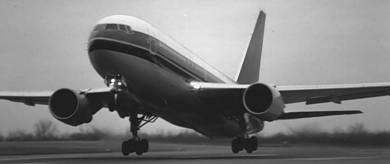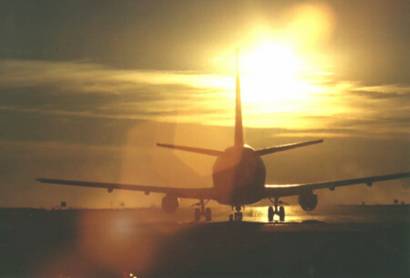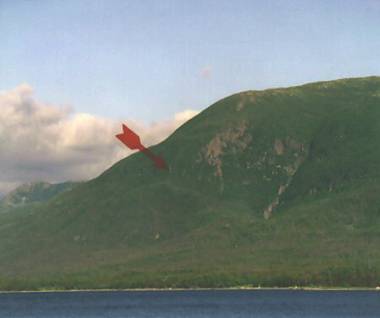Winter Shorts

Wet on takeoff? Beware of low freezing levels.
Frozen Elevator
Heading south for fun-'n'-sun, the Aztec pilot, en route from Calgary to Cabo San Luca, landed in Salt Lake City to refuel. Heavy wet snow was falling as he taxied in to the refuelling point, and quite a lot of the wet stuff accumulated on the airplane during his pit stop. The pilot carefully cleaned all of the snow off the wings and tail before taxiing out for takeoff. Even so, his efforts did not leave the surfaces clean and dry. A lot of moisture had seeped into the control hinges.
As he climbed into the colder air aloft, the moisture froze and so did his elevators. With dauntless skill and a lot of sweat, he successfully manoeuvred the Aztec back for a safe landing.
Frozen Aileron
A Boeing 767-200 was cruising at flight level, en route from the west coast to Toronto, when the aileron control became abnormal under both autopilot and manual control. The crew diverted to the nearest suitable airport. During the approach, aileron control returned to normal, and the aircraft landed without incident.
The aircraft was inspected. No fault was found. The flight was continued to Toronto.
The aircraft had been parked outside overnight at the west-coast stop and had been exposed to heavy rain. All indications are that water had entered the aileron control system, which then froze at altitude, causing the jam. During the approach into warmer temperatures, the ice melted, leaving no evidence.
With clean wings, we still need to be aware of moisture when the mercury dips below the freezing mark immediately after takeoff.
Frozen Brake
The PA31 had had an unplanned encounter with a snowbank, damaging the nose gear. The pilot was ferrying the aircraft home, gear down, for repairs. On arrival at destination, after a smooth touchdown, the frozen right brake caused the tire to blow, and our unfortunate pilot had a second encounter with a snowbank.
Warm brakes + cold snow = moisture. If you dont dry the brakes, they are guaranteed to freeze later.
Curling Rocks
Two successive Bradley Air Services B727 arrivals at Iqaluit made the smart move last winter. The only available runway at Iqaluit is 18/36. The wind was 240· at 22 kt., gusting to 34 kt. The James Brake Index (JBI) coefficient was 0.34. Both captains decided to divert 160 mi. to Kuujjuaq, an expensive decision for the company. But had they attempted the landing, only to become curling rocks immediately after touchdown, the bent aluminum would have been a lot more expensive.
Well done!
Beware of Hazards Off the Ice Strip
Overhead the frozen lake, the 185 pilot assessed the wind as moderate to strong and at 90· to the ploughed ice strip. He decided to land into the wind off the prepared strip.
Blowing snow and whiteout conditions made the approach extremely difficult. During the after-landing roll, the aircraft was severely damaged when it struck a snow ridge that the pilot could not see.
Whiteout
The 185 charter pilot departed in visual conditions and climbed to 400 ft. above ground level (AGL). Five miles later, he encountered whiteout conditions over a frozen lake. The instruments told him he was in a descending left turn. He didnt believe them because he could not feel the turn. When he finally realized that the instruments were telling the truth, it was too late. The aircraft struck the ice, tearing off the left wing. Fortunately, after all the parts came to a stop, he walked away unhurt.
Whiteout conditions mean IFR. Believe what your instruments tell you.
Originally Published: ASL 3/1997
Original Article: Winter Shorts
Visual Illusion — Near CFIT

Loss of visual acuity in low sun.
The following letter was sent anonymously to the Transportation Safety Board of Canada (TSB). The TSB thought that the message should get wide distribution and passed it to us for publication.
To whom it may concern,
Yes, we know, we know, youve read dozens of CFIT articles and it couldnt happen to you. You work very hard to maintain situational awareness, you personally identify all approach aids, and you have learned to listen more intently to ground-proximity warnings and TCAS alerts than you do to your significant other.
We do these things, too, but it still happened to us: complacency and an unusual visual phenomenon resulted in a twin-turbine aircraft with 67 people on board flying a controlled approach to a field of snow immediately to the left of a fully operational, 10,000-ft. runway!
On that mid-March afternoon, the aircraft was being flown by a two-person flight-deck crew with more than 55 years of flying experience. It was a simple arrival from the west via radar vectors and a right turn for Runway 24 at an eastern Canadian airfield. Visibility was advertised as being more than 20 mi., with only scattered cloud at 13,000 ft. The wind was blowing from 280° at 20 kt.
We completed a long right base leg, turned onto the final leg and picked up the runway visually — or so we thought. The pilot flying used a baseball cap to reduce the glare from the late afternoon sun.
The approach was flown on the PAPI-directed glideslope and on airspeed, with mechanical turbulence in the lower levels making several power adjustments necessary. Everything looked perfect for an "on-schedule" arrival until, at 200 ft., the pilot not flying said, "There's the runway — over there." An immediate correction to the right was followed by a smooth touchdown, and the aircraft cleared the runway without further incident.
Both pilots were shaken and in total disbelief at what had just happened; to set up an approach to a field of snow in these or any other conditions was beyond our wildest imaginations. What had happened?
From about 10 mi. back, we had seen, quite clearly, what we thought was the runway. The ILS/NDB information was available but was not used, since the PAPI lights were visible throughout the approach. This was a simple visual arrival on a fine day.
However, the strong north winds were picking up light fresh snow, and this had obscured the lights on the right side of the runway. The snow had also drifted across the smooth runway surface, leaving it bright white and reflecting the sunlight. The runway appeared to be an unbroken field of snow. The dimpled surface of old snow to the left of the runway, on the other hand, cast long shadows owing to the shallow angle of the afternoon suns rays. It was dark and looked, to both of us, unquestionably like the runway in use. On clearing the runway and passing on this information to the arrival controllers, two other air carrier operators immediately responded that they had also experienced the same visual illusion.
Thankfully, the two-pilot concept worked again, and pride and confidence were the only things damaged. At about 500 ft., the pilot not flying had time to question the texture of the landing surface. On closer examination, it just didnt look right, and peripheral vision enabled him to pick out the real runway surface. The fact that the approach was flown to a snowy field is frightening enough, but, when you realize that every fibre of our beings believed that what we saw was the runway, it is even more unbelievable and unnerving.
Fortunately, the solution to this problem is simple. Using all of the available approach aids would have prevented this incident, and tuning up our approach review of the airfield lighting and PAPI installation locations would also be most worthwhile for the future. In addition, clear lines of communication between crew members were of key importance to this flights successful conclusion, and the need for such communication cannot be overemphasized.
In this instance, no real damage was done, but we humbly ask that all of our fellow aviators be forewarned that, in this business, what you see is not always what you get.
Signed,
Older and Wiser
Originally Published: ASL 3/1997
Original Article: Visual Illusion - Near CFIT
A Little Skill Can Be Dangerous — Controlled Flight Into Terrain

Practice instrument flying ended here (arrow).
The Cessna 172 pilot was flying one of four aircraft rented by a group of tourists intent on a flying vacation in eastern Canada. He had over 1300 h flight time. Although he did not have an instrument rating, he had received extensive instrument-flight training in the past year. His copilot told friends that, on previous occasions, the pilot had deliberately entered cloud to demonstrate aircraft control with reference to the instruments only. The co-pilot had enjoyed the experience, and expressed confidence in the pilots abilities.
The group planned to fly from Sept Îles to Stephenville, with an en route stop in Natashquan. Each pilot had VFR maps and a global positioning system for navigation. Before departure, the leader had phoned the Sept-Îles FSS for a detailed weather briefing, and he later talked to the briefer in person at the airport. Weather in the area was generally VFR, but there was a low moving in from the south, bringing lower ceilings, rain and fog. The specialist advised that they recheck the weather during the refuelling stop at Natashquan. They filed a group flight plan and thoroughly discussed the weather.
After a pleasant flight, they refuelled in Natashquan as planned. The weather was clear and sunny; they could see for miles. Unfamiliar with the potential for maritime weather conditions to change rapidly, they did not bother to recheck the weather.
As they cruised along, approaching the Newfoundland coast, increasing cloud made it difficult to maintain contact with the ground and each other. They discussed the changing weather, but nobody called an FSS for the latest report.
Within sight of the west coast, the lead aircraft announced his position and his intent to descend. The group leader, who was flying in the number three position, could clearly see the west coast mountains in St. Pauls Inlet as he descended through 1000 ft. The steep terrain of the coastal inlet could be seen rising into the clouds. As he turned south to follow the two lead aircraft, he saw the trail aircraft enter cloud about 500 ft. higher up, still on the en route heading. He called the pilot, instructing him to turn right. His repeated calls got no response. The three remaining aircraft continued to within 33 mi. of their destination before being forced by the weather to return to Natashquan.
The trailing aircraft had impacted the coastal mountains in controlled flight. The pilot, his wife and the confident copilot were killed instantly. It is suspected that the pilot deliberately penetrated cloud to "practice his instrument skills." However, he had forgotten his navigation skills; he was obviously unaware of the deadly "cumulogranite" clouds directly in his path.
Originally Published: ASL 3/1997
Original Article: A Little Skill Can Be Dangerous - Controlled Flight Into Terrain
At 7:19 p.m., a Dash 8 on a 4-mi. final for Runway 26R at Vancouver was struck by lightning. The aircraft landed safely.
Fifteen minutes later, a Boeing 767 on an 8-mi. final for the same runway was also struck by lightning. This aircraft also landed safely.
Ten minutes later, yet another aircraft, a Boeing 737 4 mi. back from the same runway threshold, was struck by lightning, but it too landed safely.
So, over a 25-min. period, there were three approaches and three lightning strikes.
How many other aircraft pressed on, unscathed, through the thunderstorms during the evening rush hour?
The three unfortunates who were struck were all equipped with weather radar. It is hard to believe that, flying through an area of active cumulonimbus clouds (CBs), the pilots did not have the scopes lit up; that pilots would deliberately push through active CBs on the approach path that the first pilot did not report the strike immediately; that the controller did not warn off the other arriving aircraft; and that the following pilots chose not to hold until the storm had passed.
The lightning could easily have fried the aircrafts electronics, and the potential hazards of hail, severe turbulence and windshear were all there.
Is meeting the schedule worth the risks?
Originally Published: ASL 3/1997
Original Article: Struck by Lightning




























